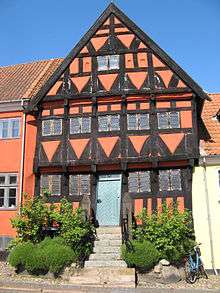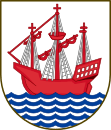Middelfart
| Middelfart | ||
|---|---|---|
|
Saint Nicolaus Church in late-July 2003 | ||
| ||
 Middelfart Location in the Region of Southern Denmark | ||
| Coordinates: DK 55°29′55″N 9°44′40″E / 55.49861°N 9.74444°ECoordinates: DK 55°29′55″N 9°44′40″E / 55.49861°N 9.74444°E | ||
| Country | Denmark | |
| Region | Southern Denmark (Syddanmark) | |
| as Mæthælfar | 1231 | |
| as Middelfart | 1496 | |
| Middelfart Municipality | 1970 | |
| Population (2014) | ||
| • Total | 14,815 | |
| Time zone | CET (UTC+1) | |
| • Summer (DST) | CEST (UTC+2) | |
| Postal code | 5500 | |
| Area code(s) | (+45) 3 | |
| Website | www.middelfart.dk | |
Middelfart is a town in central Denmark, with a population of 14,815 (1 January 2014).[1] The town is the municipal seat of Middelfart Municipality on the island of Funen (Danish: Fyn).
Etymology
The name Middelfart, first recorded as "Mæthælfar" in Valdemar's Census Book in 1231, consists of the old Danish word mæthal meaning "middle" and far meaning "way". This name originally referred to the strait Snævringen ("the narrowing"), which is the narrowest part of the Little Belt, and was subsequently applied to the settlement, as well.[2]
History
It is not known when the town was established but it certainly owes its existence to its location at the narrowest point across the Little Belt. The town was granted its first privileges at the end of the 13th century at a time when fishing played an important role in addition to its ferry link to Snoghøj in Jutland. From the Middle Ages, the town appears to have specialized in catching harbour porpoises. In the 16th century, cattle export was also significant.[3]
After the Swedish Wars in the 17th century, the town suffered from losing its foreign export privileges as well as competition from Fredericia on the other side of the belt which not only had a ferry link to Strib but levied customs duties on traffic through the Little Belt. In the 18th century, income from porpoise catches diminished but in the 19th century, with the establishment of its own harbour in 1836, conditions improved thanks in particular to the growing trade in agricultural products from the surrounding areas. From the mid-19th century, small industries started to develop, especially the iron foundry. The rail link between Middelfart and Nyborg opened in 1865 bringing added prosperity despite the fact that it connected with the ferry from Strib rather than the one from Middelfart.[3]
By the beginning of the 20th century, the iron foundry, with about a hundred workers, was the town's main industry. After the first Little Belt Bridge was completed in 1935, Middelfart became an important hub for traffic between Jutland and Funen. The population exploded from 2,345 in 1880 to 11,056 in 1950 although in the second half of the 20th century the rate of growth declined. In 1970, a motorway bridge to Jutland was opened and in 2007 Middelfart became the seat of an expanded municipality which included the former communes of Ejby and Nørre Aaby.[3]
Economy and transport

Middelfart Municipality had a population of 37,685 in January 2014. The municipality is also a part of the East Jutland metropolitan area with 1.2 million inhabitants.[4]
From the Middle Ages until the end of the 19th century, the local fishermen were also whale hunters in winter. The only whale common in Danish waters is the Harbour Porpoise Phocoena phocaena. The whale hunters linked their boats across the rather narrow Little Belt and by beating the sea with sticks and branches they directed the migrating porpoises to low water areas where they could be slaughtered. As the whale blubber was used for lamps, indoors and outdoors, the arrival of electricity made whale hunting uneconomical. In the winter of 1854–55, 1742 whales were caught, but a normal winter's catch would only be half of this number or even less. In the 20th century, the hunt was resumed during the two world wars. Two memorial stones now stand where the hunters landed the whales and where blubber was prepared.
Middelfart is served by the passenger rail service between Copenhagen and Jutland. Gammel Havn (Old Harbour) dates from the 1830s. At the beginning of the 20th century, it was extended and deepened to the east.[5]
Landmarks
Middelfart Church, dedicated to St Nicholas, is located close to the harbour at the end of Algade. Built in several stages, it has a Late Romanesque chancel, a tower first constructed in the 14th century and a nave with lateral aisles from the late 15th century. The richly carved altarpiece is from 1650.[6]
Henner Friiser Hus, a half-timbered house on Brogade from around 1575, is now part of Middelfart Museum offering exhibitions related to the town's history. Restoration work on the building was completed in March 2014.[7]
The Cultural Center Kulturøen (literally, "Culture Island"), contains the town library, a cinema, a restaurant, a café, and the tourist office.[8]
Sport
Middelfart is home to football team Middelfart G&BK. Middelfart played host to the 1998 UCI World Cyclocross championships.
Notable people
- Christian Eriksen, Tottenham Hotspur and Denmark football player.
- Lonnie Kjer (known as Lonnie Devantier), the Danish representative at the Eurovision Song Contest 1990.
- Rasmus Falk, FC Copenhagen football player.
Twin towns – Sister cities
Middelfart is twinned with:
 Oskarshamn, Sweden[9]
Oskarshamn, Sweden[9]
References
- ↑ BEF44: Population 1st January, by urban areas database from Statistics Denmark
- ↑ "Skt. Nikolaj Kirke" (PDF) (in Danish). Danske Kirker: National Museet. Retrieved 11 July 2014.
- 1 2 3 "Købstæder: Middelfart" (in Danish). Dansk Center for Byhistorie. Retrieved 9 July 2014.
- ↑ "BEF44: Population 1. January by urban areas". Statistics Denmark. Retrieved 12 July 2014.
- ↑ "Middelfart" (in Danish). Den Store Danske. Retrieved 10 July 2014.
- ↑ "Middelfart Kirke" (in Danish). Den Store Danske. Retrieved 11 July 2014.
- ↑ "Middelfart Museum - Henner Friiser Hus" (in Danish). Visit Middelfart. Retrieved 11 July 2014.
- ↑ "KulturØen i Middelfart" (in Danish). Middelfart Bibliotek. Retrieved 10 July 2014.
- ↑ Lindquist, Ted. "Internationella frågor och vänorter". Oskarshamn Municipality (in Swedish). Retrieved 25 July 2013.

